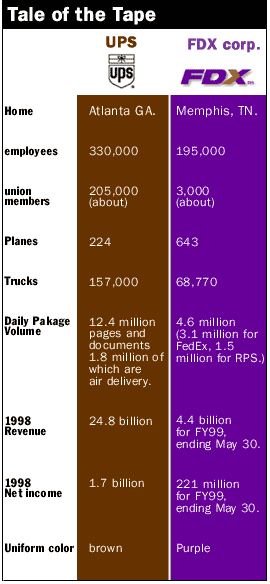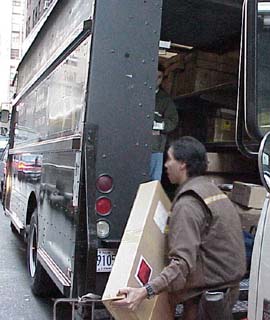|
Lots of green for Big Brown
|
 |
November 9, 1999: 5:08 p.m. ET
Strong UPS profits, Web shopper use equals record $5.5B IPO, $50 share price
By Staff Writer Chris Isidore
|
NEW YORK (CNNfn) - United Parcel Service, which dominates the package delivery industry, is set to dominate Wall Street Wednesday when its record $5.5 billion initial public offering rolls into town.
Late Tuesday, the company priced its offering at $50 a share, a dollar above the proposed $47 to $49 range announced Friday.
The IPO price represents a 96 percent gain from the 25-1/2 price for each of the privately-traded shares now held by employees and retirees of the Atlanta parcel delivery giant.
The 109.4 million shares being sold by UPS represent a 10 percent stake in the company. UPS will receive about $5.3 billion after expenses. The underwriters of the deal, which include most of the major investment banks on Wall Street, also have an over-allotment of 10.9 million shares, worth an additional $547 million.
The sale will beat the record $4.4 billion for a U.S. IPO set in October, 1998, when DuPont Co. sold off the first 30 percent of its stake in Conoco Inc.
IPO size in keeping with Atlanta giant
The issue is one of the most eagerly-anticipated, given the strength of both the company's balance sheet and its dominance in the trucking and parcel delivery industry, and its strength in delivery of goods purchased by consumers on the Internet.
It is estimated that 5 percent of all commerce in the United States in its trucks. More people work for it than live in major league cities as varied as Buffalo, N.Y., Tampa, Fla., or Anaheim, Calif. And it had more than $2.6 billion in cash on hand at the end of its most recent quarter.
The Atlanta parcel delivery giant reaches virtually every home and office in the United States, and more than 200 countries around the globe.
The question for investors is whether the price of the stock, and similarly large multiples are justified.

About 5 percent of the GDP, and most Internet purchases by consumers, move inside one of these trucks.
The package delivery company, which will trade on the New York Stock Exchange under the symbol UPS, will start with a market capitalization of $54.7 billion. UPS reported earnings not including charges of $1.95 billion for the 12 month period ending Sept. 30, giving it a price to earnings ratio of 28 times trailing earnings, in line with the S&P average of 27.5.
An Internet company with profits
But one of the things that so excites some investors is the idea that Big Brown, with its gold-plated balance sheet and huge cash flow, is actually a closet Internet play.
Its mix of low-cost ground service and more pricey overnight service has made it the delivery company of choice for consumers ordering goods off the Web, according to a study last year by Zona Research, which found that 55 percent of consumers generally used UPS for their e-tailing purchases. Another 32 percent generally use the U.S. Postal Service, and only 10 percent generally used Federal Express Corp., the well-known subsidiary of FDX Corp. (FDX)
"I don't think it'll double in the first day like some Internet stocks, but I'm guessing it'll get a first day bounce," said one analyst, who asked that his name not be used. "Ultimately it'll move towards 60. That'll be a little high, but truth is no one knows what it's worth. Even at 25 times (future) earnings, it'll be a cheap surrogate to a real e-commerce stock."
The issue is so large that pieces have been spread around to enough investment banks to place golden gags in the mouths of virtually every trucking analyst, who can't speak on the record because of the quiet period. The lead manager is Morgan Stanley Dean Witter, while Goldman Sachs and Merrill Lynch & Co. are acting as senior co-managers, while Credit Suisse First Boston, Solomon Smith Barney and Warburg Dillon Read are the co-managers in the syndicate as well. But there are many managers not in the syndicate who have a big enough piece that they can't comment for the record either.
Risk even in Internet deliveries
The trucking analysts believe that those who see UPS as an Internet play are missing the point that the home-delivery business is among the least profitable part of UPS's offerings. The company sees its greatest profits with the greatest density of deliveries, and thus gets most of its profits from business-to-business deliveries.
While b-to-b Internet commerce is also climbing, UPS faces far more challengers for that business.
Its lead in delivering consumer Internet purchases is also under pressure. The U.S. Postal Service this year started offering shippers the ability to get electronic delivery confirmation, providing another low-cost option to UPS. FDX Corp., owner of FedEx, is having another one its subsidiary, lower-cost ground parcel delivery service RPS branch out from its business-to-business focus to start home deliveries in urban and suburban areas for the first time.
"Anyone in this market needs to be careful," said Clay Ryder, vice president and chief analyst for Zona Research. "The Internet is a place where choices change quickly. UPS has a good lead, but it can't take it for granted."
One of the trucking analysts stressed that investors shouldn't get carried away with either the glitter or the gold of UPS's offering. He said if the stock is trading above 60 when he can finally establish coverage on the stock in a few weeks, he may open with a neutral rating.
What's a reasonable multiple?
"If it its above 60, you're talking 25, 26, 27 times future earnings," he said. "It's a great company, but we think there are better ideas to buy guys who don't have those kind of multiples."
FDX, its prime competitor, trades at a P/E ratio of about 19. Its stock may have been hurt in recent week as portfolio managers who wanted to only so much freight transportation stock sold shares to make room for UPS. The UPS road show also included numbers suggesting it was winning some market share of FDX's core overnight-delivery business in recent quarters.
But FDX, which has a market capitalization of $13.1 billion, could be helped in the future if UPS shows it can maintain the stronger multiples, because it could improve investors' opinion of where the sector should trade.

Still, the trucking analyst said that unlike other Internet plays, UPS is susceptible to problems like oil price shocks and labor problems. The heavily-unionized company, with more than 200,000 union members among its 330,000-person work force, was hit with a two-week strike by the Teamsters union in August, 1997 that cost it at least $750 million in revenue.
"During the strike, Wall Street would have crushed the stock," said the analyst.
Financial clouds on horizon
The company took a $1.4 billion charge in the most recent quarter in relation to a tax dispute involving its offshore insurance operations. Its IPO prospectus said that charge could rise to a $2.35 billion under a worst-case scenario. Some also expect it to take a non-cash charge in the hundreds of millions soon to account for its share of underfunding in multi-employer pension plans run by the Teamsters, plans that the company took a strike in an effort to exit in 1997.
Still, despite those clouds that would be enough to level the balance sheet of a lesser company, UPS does not need the offering to raise money.
In fact it will take the $5-billion plus in proceeds and repurchase shares from existing shareholders, whose shares will have 10 times the voting rights of the shares offered to the public this week. Beside the cash the company has on hand, it has the best debt rating of any corporation and an expected cash flow of billions more next year.
The company said at the time of its announcement in July that it needed the IPO in order to use the stock as currency in future acquisitions, especially in response to a buying-spree taking place this year by recently-privatized European postal authorities. Some believe that this suggests it is looking at buying technology companies with its new stock.
"The valuation for technology companies are very high," said Ullas Naik, senior vice president of research and an IPO expert for FAC Equities. "Why would you pay cash for that, why not pay with another inflated stock?"
An instant blue chip
There isn't as much upside potential for UPS stock as there is for many IPOs, both technology and non-technology. The lack of rapid growth in income or profits and even the absence of a chance of being purchased by a large company means that the triple-digit percentage gains are not going to happen, said Ben Holmes, founder of ipoPros.com, a Boulder, Colo., online research company.
"Most people these days expect IPOs to pop 300-400-500 percent as a matter of course. This one will not do this," said Holmes. "I think this trades at a reasonable and rational multiple. I would expect it to trade at 20 to 30 percent premium above issue price."
What UPS loses in interest by IPO gamblers, it gains with interest by large institutional buyers, which are precluded from buying the riskier small capitalization stocks for the most part.
"It takes the position of an instant blue chip," said Holmes. "It becomes an institutional darling almost immediately."
Employee-owned history
The company gave a secondary reason for the IPO the desire to create a market for the stock held by its employee-owners. It already has more shareholders than most publicly-held companies, with 126,000 different owners.
It's managers have been able to buy the stock, or were paid in stock, for most of its 97-year history. Hourly employees have had a right to buy the stock since 1995.
While most of the shares are held by managers, even many of the hourly employees are going to see a nice bump in their portfolio, especially since UPS has traditionally paid the best wages in the trucking industry.

UPS delivery driver Bobby Hernandez is one of 126,000 shareholders, about half of which are current employees, who will see a nice jump in their portfolio this week.
The top hourly pay at UPS is now over $21 an hour. If an rank-and-file employee was buying $1,000 of the stock a quarter, or about 10 percent of his or her base salary, since 1995, they likely have just less than 700 shares of the stock today, with a value of just under $35,000. But those shares will essentially be split before the IPO, and at the 50 IPO price, their portfolio will top $68,000 right from the start.
"It's a good retirement fund, a solid company," said Bobby Hernandez, a UPS delivery driver working in mid-town Manhattan this week. "It certain is better than the banks. But is it enough to retire on? No."
There is a possibility of retirement for many of the managers, though, who saw a share of their compensation be in stock over the years. Already John Alden, the company's 57-year old vice chairman who was credited by the with leading UPS's e-commerce efforts, has announced plans to retire. He'll see the value of his portfolio jump from $10 million to $19.6 million, not including options, at the IPO price.
Many front-line managers could also see an unexpected pay-day from the issue, and there is a certain risk of brain-drain from that pay-day.
|
|
|
|
|
 |

|

